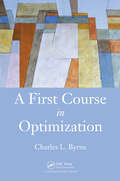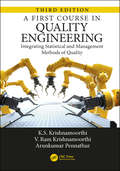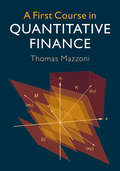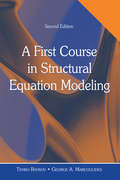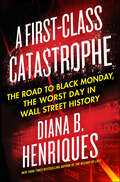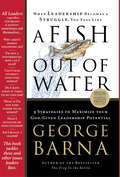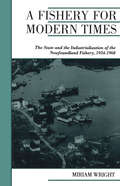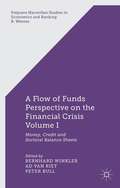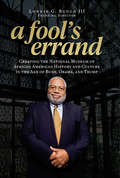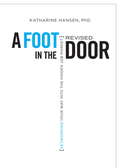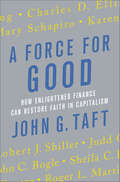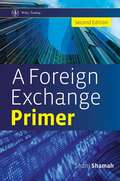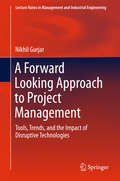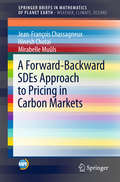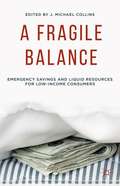- Table View
- List View
A First Course in Machine Learning
by Mark GirolamiA First Course in Machine Learning covers the core mathematical and statistical techniques needed to understand some of the most popular machine learning algorithms. The algorithms presented span the main problem areas within machine learning: classification, clustering and projection. The text gives detailed descriptions and derivations for a smal
A First Course in Machine Learning
by Mark Girolami Simon Rogers"A First Course in Machine Learning by Simon Rogers and Mark Girolami is the best introductory book for ML currently available. It combines rigor and precision with accessibility, starts from a detailed explanation of the basic foundations of Bayesian analysis in the simplest of settings, and goes all the way to the frontiers of the subject such as infinite mixture models, GPs, and MCMC."—Devdatt Dubhashi, Professor, Department of Computer Science and Engineering, Chalmers University, Sweden "This textbook manages to be easier to read than other comparable books in the subject while retaining all the rigorous treatment needed. The new chapters put it at the forefront of the field by covering topics that have become mainstream in machine learning over the last decade."—Daniel Barbara, George Mason University, Fairfax, Virginia, USA "The new edition of A First Course in Machine Learning by Rogers and Girolami is an excellent introduction to the use of statistical methods in machine learning. The book introduces concepts such as mathematical modeling, inference, and prediction, providing ‘just in time’ the essential background on linear algebra, calculus, and probability theory that the reader needs to understand these concepts."—Daniel Ortiz-Arroyo, Associate Professor, Aalborg University Esbjerg, Denmark "I was impressed by how closely the material aligns with the needs of an introductory course on machine learning, which is its greatest strength…Overall, this is a pragmatic and helpful book, which is well-aligned to the needs of an introductory course and one that I will be looking at for my own students in coming months."—David Clifton, University of Oxford, UK "The first edition of this book was already an excellent introductory text on machine learning for an advanced undergraduate or taught masters level course, or indeed for anybody who wants to learn about an interesting and important field of computer science. The additional chapters of advanced material on Gaussian process, MCMC and mixture modeling provide an ideal basis for practical projects, without disturbing the very clear and readable exposition of the basics contained in the first part of the book." —Gavin Cawley, Senior Lecturer, School of Computing Sciences, University of East Anglia, UK "This book could be used for junior/senior undergraduate students or first-year graduate students, as well as individuals who want to explore the field of machine learning…The book introduces not only the concepts but the underlying ideas on algorithm implementation from a critical thinking perspective."—Guangzhi Qu, Oakland University, Rochester, Michigan, USA
A First Course in Optimization
by Charles ByrneGive Your Students the Proper Groundwork for Future Studies in OptimizationA First Course in Optimization is designed for a one-semester course in optimization taken by advanced undergraduate and beginning graduate students in the mathematical sciences and engineering. It teaches students the basics of continuous optimization and helps them better
A First Course in Quality Engineering: Integrating Statistical and Management Methods of Quality, Third Edition
by K. S. Krishnamoorthi V. Ram Krishnamoorthi Arunkumar PennathurThe third edition of this textbook improves on the strengths of the earlier editions both in content and presentation. Of the important features of the textbook is the inclusion of examples from real-world to illustrate use of quality methods in problem solving. A thorough revision is made of the text to make all chapters suitable for self-study as well.
A First Course in Quantitative Finance
by Thomas MazzoniThis new and exciting book offers a fresh approach to quantitative finance and utilizes novel new features, including stereoscopic images which permit 3D visualization of complex subjects without the need for additional tools. Offering an integrated approach to the subject, A First Course in Quantitative Finance introduces students to the architecture of complete financial markets before exploring the concepts and models of modern portfolio theory, derivative pricing, and fixed-income products in both complete and incomplete market settings. Subjects are organized throughout in a way that encourages a gradual and parallel learning process of both the economic concepts and their mathematical descriptions, framed by additional perspectives from classical utility theory, financial economics, and behavioral finance. Suitable for postgraduate students studying courses in quantitative finance, financial engineering, and financial econometrics as part of an economics, finance, econometric, or mathematics program, this book contains all necessary theoretical and mathematical concepts and numerical methods, as well as the necessary programming code for porting algorithms onto a computer.
A First Course in Quantitative Finance
by Thomas MazzoniThis new and exciting book offers a fresh approach to quantitative finance and utilises novel features, including stereoscopic images which permit 3D visualisation of complex subjects without the need for additional tools. Offering an integrated approach to the subject, A First Course in Quantitative Finance introduces students to the architecture of complete financial markets before exploring the concepts and models of modern portfolio theory, derivative pricing and fixed income products in both complete and incomplete market settings. Subjects are organised throughout in a way that encourages a gradual and parallel learning process of both the economic concepts and their mathematical descriptions, framed by additional perspectives from classical utility theory, financial economics and behavioural finance. Suitable for postgraduate students studying courses in quantitative finance, financial engineering and financial econometrics as part of an economics, finance, econometric or mathematics program, this book contains all necessary theoretical and mathematical concepts and numerical methods, as well as the necessary programming code for porting algorithms onto a computer.
A First Course in Structural Equation Modeling
by George A. Marcoulides Tenko RaykovIn this book, authors Tenko Raykov and George A. Marcoulides introduce students to the basics of structural equation modeling (SEM) through a conceptual, nonmathematical approach. For ease of understanding, the few mathematical formulas presented are used in a conceptual or illustrative nature, rather than a computational one. Featuring examples from EQS, LISREL, and Mplus, A First Course in Structural Equation Modeling is an excellent beginner’s guide to learning how to set up input files to fit the most commonly used types of structural equation models with these programs. The basic ideas and methods for conducting SEM are independent of any particular software. Highlights of the Second Edition include: • Review of latent change (growth) analysis models at an introductory level • Coverage of the popular Mplus program • Updated examples of LISREL and EQS • A CD that contains all of the text’s LISREL, EQS, and Mplus examples. A First Course in Structural Equation Modeling is intended as an introductory book for students and researchers in psychology, education, business, medicine, and other applied social, behavioral, and health sciences with limited or no previous exposure to SEM. A prerequisite of basic statistics through regression analysis is recommended. The book frequently draws parallels between SEM and regression, making this prior knowledge helpful.
A First-Class Catastrophe: The Road to Black Monday, the Worst Day in Wall Street History
by Diana B. HenriquesThe definitive account of the crash of 1987, a cautionary tale of how the U.S. financial system nearly collapsed--from the bestselling author of The Wizard of LiesMonday, October 19, 1987, was by far the worst day in Wall Street history. The market fell 22.6 percent – almost twice as bad as the worst day of 1929 – equal to a one-day loss of nearly 5,000 points today.Black Monday was more than seven years in the making and threatened nearly every U.S. financial institution. Drawing on superlative archival research and dozens of original interviews Diana B. Henriques weaves a tale of missed opportunities, market delusions, and destructive actions that stretched from the “silver crisis” of 1980 to turf battles in Washington, a poisonous rivalry between the New York Stock Exchange and the Chicago Mercantile Exchange, and the almost-fatal success of two California professors whose idea for reducing market risk spun terribly out of control. As the story hurtles forward, the players struggle to forestall a looming market meltdown and unexpected heroes step in to avert total disaster.For thirty years, investors, regulators, and bankers have failed to heed the lessons of 1987, even as the same patterns have resurfaced, most spectacularly in the financial crisis of 2008. A First-Class Catastrophe offers a new way of looking not only at the past, but at our financial future as well.
A Fish Out of Water
by George BarnaBarna unveils the results of years of research and hundreds of interviews, and emerges with a new definition of what leadership is--and isn't.
A Fishery for Modern Times
by Miriam WrightIn the early 1990s, the northern cod populations off the coast of Newfoundland had become so depleted that the federal government placed a moratorium on commercial fishing. The impact was devastating, both for Newfoundland's economy and for local fishing communities. Today, although this natural resource - exploited commercially for over 500 years - appears to be returning in diminished numbers, many fisheries scientists and fishers question whether the cod will ever return to its former abundance.In A Fishery for Modern Times, Miriam Wright argues that the recent troubles in the fishery can be more fully understood by examining the rise of the industrial fishery in the mid-twentieth century. The introduction of new harvesting technologies and the emergence of 'quick freezing', in the late 1930s, eventually supplanted household production by Newfoundland's fishing families. While the new technologies increased the amount of fish caught in the northwest Atlantic, Wright argues that the state played a critical role in fostering and financing the industrial frozen fish sector. Many bureaucrats and politicians, including Newfoundland's premier, Joseph Smallwood, believed that making the Newfoundland fishery 'modern', with centralization, technology, and expertise, would transform rural society, solving deep-seated economic and social problems.A Fishery for Modern Times examines the ways in which the state, ideologies of development, and political, economic, and social factors, along with political actors and fishing company owners, contributed to the expansion of the industrial fishery from the 1930s through the 1960s. While the promised prosperity never fully materialized, the continuing reliance on approaches favouring high-tech, big capital solutions put increasing pressure on cod populations in the years that followed. As Wright concludes, 'We can no longer afford to view the fisheries resources as "property" of the state and industry, to do with it as they choose. That path had led only to devastation of the resource, economic instability, and great social upheaval.'
A Fitting Test: Real World Strategies for Moving from Innovation to Application, Protecting Intellectual Property, and Avoiding Imitation
by Jay Barney Patricia Gorman Clifford"What I Didn't Learn in Business School" is a fictional account that follows new consultant Justin Campbell as he joins an elite consulting team hired by a chemical firm to assess the potential of a newly developed technology. As Justin and his team are given a glimpse into the many possible applications for this new technology, he realizes the gravity of their mandate. This is no business school exercise; the recommendation they make about which strategic direction their client should choose will determine the future of the company. In this chapter, Justin and his team get to work testing ideas, evaluating the risks of imitation by competitors. This chapter was originally published as Chapter 10 of "What I Didn't Learn in Business School: How Strategy Works in the Real World."
A Flow-of-funds Perspective On The Financial Crisis
by Peter Bull Bernhard Winkler Ad Van RietProvides a comprehensive overview of a broad range of uses of the flow of funds within the central bank community as well as in the academic field, prepared by international experts in the field. Based on the crisis experience, it offers an overview of lessons for macrofinancial analysis and financial stability.
A Flow-of-funds Perspective On The Financial Crisis
by Peter Bull Bernhard Winkler Ad Van RietProvides a comprehensive overview of a broad range of uses of the flow of funds within the central bank community as well as in the academic field, prepared by international experts in the field. Based on the crisis experience, it offers an overview of lessons for macrofinancial analysis and financial stability.
A Fool's Errand: Creating the National Museum of African American History and Culture in the Age of Bush, Obama, and Trump
by Lonnie G. Bunch IIIFounding Director Lonnie Bunch's deeply personal tale of the triumphs and challenges of bringing the Smithsonian National Museum of African American History and Culture to life. His story is by turns inspiring, funny, frustrating, quixotic, bittersweet, and above all, a compelling read.In its first four months of operation, the Smithsonian National Museum of African American History and Culture surpassed one million visits and quickly became a cherished, vital monument to the African American experience. And yet this accomplishment was never assured. In A Fool's Errand, founding director Lonnie Bunch tells his story of bringing his clear vision and leadership to bear to realize this shared dream of many generations of Americans. Outlining the challenges of site choice, architect selection, building design, and the compilation of an unparalleled collection of African American artifacts, Bunch also delves into his personal struggles--especially the stress of a high-profile undertaking--and the triumph of establishing such an institution without mentors or guidebooks to light the way. His memoir underscores his determination to create a museum that treats the black experience as an essential component of every American's identity.This inside account of how Bunch planned, managed, and executed the museum's mission informs and inspires not only readers working in museums, cultural institutions, and activist groups, but also those in the nonprofit and business worlds who wish to understand how to succeed--and do it spectacularly--in the face of major political, structural, and financial challenges.
A Force for Good: How Enlightened Finance Can Restore Faith in Capitalism
by John G. TaftAfter the crisis of 2008, the social contract between the financial industry and everyone else was badly broken-perhaps, it seemed, irrevocably. Since then, banks have paid out billion-dollar settlements and Congress has passed some new laws, but a deeper rapprochement is still missing. John Taft has gathered some of the greatest financial minds of our time to explore how Wall Street can harness the same creative energy that invented credit default swaps and channel it towards the public good- in the form of a stable retirement system, investment strategies that protect the environment and reward responsible corporate behavior, and a financial industry with a culture of ethics, integrity and client focus. These perspectives, from a who's who of leaders in the field, offer a blueprint for a new kind of responsible finance and banking that secures the future for everyone. Contributors include: * Robert Shiller on financial capitalism and innovation*Charles D. Ellis on restoring ethical standards*Sheila Bair on regulatory reform *John C. Bogle and Mary Schapiro on rebuilding investor trust *Judd Gregg on long-term fiscal imbalances *Barbara Novick on the retirement savings gap *David Blood on sustainable finance.With so much brainpower in the financial sector, the potential for change is limitless. A Force for Good is the call to action the industry sorely needs.
A Foreign Exchange Primer
by Shani ShamahThis book will provide a thorough introduction to the foreign exchange markets, looking at the main products through to the techniques used, coverage of the main participants, details of the various players, and an understanding of the jargon used in everyday dealings. Written in a concise and accessible manner, it will be an ideal introduction for anyone looking to become involved in the FX markets, from dealing rooms or sales perspectives, to novice investors.The new edition has been updated to reflect the changes that have taken place in the industry over the past few years. Most chapters have been enhanced and this new edition now features new material on the psychology of trading, the psychology of price movement and online trading.
A Forest Environment Tax Scheme in Japan: Toward Water Source Cultivation
by Keiko NakayamaThis book is a work that focuses on the forest environmental tax. Forest resources have played a major role in preventing global warming by absorbing carbon dioxide and supplying oxygen. However, global economic growth has adversely affected the global environment and has exacerbated global warming due to excessive consumption of forest resources. The functions or “services” of forests are diverse, but the interest of the citizenry in forest cultivation is scarce since forests are public goods. Concurrently, Japanese forestry, which has played an important role in forest conservation, is steadily declining, and it is no longer possible for private forest operators to maintain the forest environment. Therefore, in order to realize sustainable economic growth, it is necessary to formulate policies for the conservation of appropriate forest environments. Forest conservation is an especially important policy issue for Japan, where two-thirds of the country is forested. In Japan, a forest environmental tax is being introduced as a forest conservation policy. As of 2021, the forest environmental tax has already been introduced in about two-thirds of the prefectures and soon will be introduced as a national tax. In this book, the significance and issues of the forest environmental tax will be sorted out, and the status of the introduction of the forest environmental tax in Japan will be compared with that of other countries. In addition, there is additional material regarding the water source conservation fund in Toyota City, Aichi Prefecture, a system similar to the forest environmental tax.
A Forward Looking Approach to Project Management: Tools, Trends, and the Impact of Disruptive Technologies (Lecture Notes in Management and Industrial Engineering)
by Nikhil GurjarThis book is intended as a basis for advanced treatment of concepts in project management. In the current scenario where most questions are answered through the internet, the knowledge element in project management has come under the influence of disruptive technologies. In other words, project managers no longer get 'points' for knowing something that is easily available on the internet. This has far-reaching consequences. The present day project managers need to orient themselves to newer benchmarks of what is required for success on the business front. This book deals with a few such advanced concepts in project management. This book is not designed as an elementary primer to the field of project management, rather it is an advanced level treatment on the subject, to be read after the preliminary study has already been completed. The book is designed for practicing project managers, and graduate students in engineering and management, who need to understand the dynamics that are typically encountered in a project-based environment. The content in the book is based on extensive study of literature and training programs. Many of the tools have been developed on the basis of modeling and simulation methods that are specially designed by the author. These were tested at several live projects across the globe. Most of the exercises in the book are actually meant for the reader to perform as they go. The book is not designed with a 'read-all-and-come-back-later' approach, rather it focuses on 'learning by doing', whereby the reader is expected to do the exercises before reading on. The book will prove useful in self-learning, as well as in classroom teaching and professional training programs.
A Forward-Backward SDEs Approach to Pricing in Carbon Markets (Mathematics of Planet Earth)
by Jean-François Chassagneux Hinesh Chotai Mirabelle MuûlsIn Mathematical Finance, the authors consider a mathematical model for the pricing of emissions permits. The model has particular applicability to the European Union Emissions Trading System (EU ETS) but could also be used to consider the modeling of other cap-and-trade schemes. As a response to the risk of Climate Change, carbon markets are currently being implemented in regions worldwide and already represent more than $30 billion. However, scientific, and particularly mathematical, studies of these carbon markets are needed in order to expose their advantages and shortcomings, as well as allow their most efficient implementation. This Brief reviews mathematical properties such as the existence and uniqueness of solutions for the pricing problem, stability of solutions and their behavior. These fit into the theory of fully coupled forward-backward stochastic differential equations (FBSDEs) with irregular coefficients. The authors present a numerical algorithm to compute the solution to these non-standard FBSDEs. They also carry out a case study of the UK energy market. This involves estimating the parameters to be used in the model using historical data and then solving a pricing problem using the aforementioned numerical algorithm. The Brief is of interest to researchers in stochastic processes and their applications, and environmental and energy economics. Most sections are also accessible to practitioners in the energy sector and climate change policy-makers.
A Fragile Balance
by J. Michael CollinsA Fragile Balance examines strategies to promote emergency savings, especially among underserved households. Each chapter is by an expert contributor and proposes an innovative financial product or service designed to bolster emergency savings among low-asset families. This collection also offers readers insights into the role of emergency savings and mechanisms to facilitate savings behaviors, and raises critical questions of the scale, institutional capacity, sustainability, accessibility, and effectiveness of existing programs.
A Framework For Marketing Management
by Philip Kotler Kevin Lane KellerFor graduate and undergraduate courses in marketing management. A Succinct Guide to 21st Century Marketing Management Framework for Marketing Management is a concise, streamlined version of Kotler and Keller's fifteenth edition of Marketing Management , a comprehensive look at marketing strategy. The book's efficient coverage of current marketing management practices makes for a short yet thorough text that provides the perfect supplement for incorporated simulations, projects, and cases. The Sixth Edition approaches the topic of marketing from a current standpoint, focusing its information and strategy on the realities of 21st century marketing. Individuals, groups, and companies alike can modernize their marketing strategies to comply with 21st century standards by engaging in this succinct yet comprehensive text.
A Framework for Developing Secondary Markets for Government Securities
by Zsófia Árvai Geoffrey HeenanA report from the International Monetary Fund.
A Framework for Ethical Reasoning
by Sandra J. SucherA practical framework for evaluating the ethical dimensions of a proposed course of action for managers and executives.
A Framework for Financial Market Development
by Sunil Sharma Ralph Chami Connel FullenkampA report from the International Monetary Fund.


